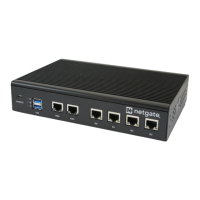Product Manual, TNSR 19.02
Fig. 3: Rear view of the Netgate 6100 MAX Secure Router
The numbered labels in this image rerfer to entries in Networking Ports and Other Ports.
Table 2: Netgate 6100 Network Interface Layout
Port Label Linux Label TNSR Label Port Type Port Speed
WAN1 enp2s0f1 GigabitEthernet2/0/1 RJ-45/SFP 1 Gbps
WAN2 enp2s0f0 GigabitEthernet2/0/0 RJ-45/SFP 1 Gbps
WAN3 enp3s0f0 TenGigabitEthernet3/0/0 SFP 1/10 Gbps
WAN4 enp3s0f1 TenGigabitEthernet3/0/1 SFP 1/10 Gbps
LAN1 enp4s0 TwoDotFiveGigabitEthernet4/0/0 RJ-45 2.5 Gbps
LAN2 enp5s0 TwoDotFiveGigabitEthernet5/0/0 RJ-45 2.5 Gbps
LAN3 enp6s0 TwoDotFiveGigabitEthernet6/0/0 RJ-45 2.5 Gbps
LAN4 enp7s0 TwoDotFiveGigabitEthernet7/0/0 RJ-45 2.5 Gbps
Note: Default Host OS Interface is enp2s0f0. The Host OS Interface is one network interface that is only available
to the host OS and not available in TNSR. Though technically optional, the best practice is to have one for accessing
and updating the host OS.
SFP+ Ethernet Ports
WAN3 and WAN4 are discrete ports, each with dedicated 10 Gbps back to the Intel SoC.
Warning: The built-in SFP interfaces on C3000 systems do not support modules utilizing copper Ethernet con-
nectors (RJ45). As such, copper SFP/SFP+ modules are not supported on this platform.
Note: Intel notes the following additional limitations on these interfaces:
Devices based on the Intel(R) Ethernet Connection X552 and Intel(R) Ethernet Connection X553 do not support the
following features:
• Energy Efficient Ethernet (EEE)
• Intel PROSet for Windows Device Manager
• Intel ANS teams or VLANs (LBFO is supported)
1.1. Netgate Appliances 14

